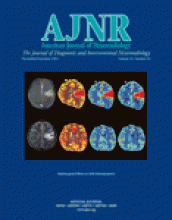Abstract
Summary: Currently, most carotid artery pathologic abnormalities resulting in pseudoaneurysm formation or stenosis are repaired by surgical intervention. Because surgical intervention requires proximal and distal control of the artery, pseudoaneurysms near the skull base may be very difficult to repair and pose greater risk to the patient. As a result, endovascular techniques have evolved in an effort to reduce morbidity associated with surgical techniques. Parent vessel occlusion and coil placement are the most frequently used endovascular techniques for carotid artery repair of pseudoaneurysms. Intimal hyperplasia is generally treated with balloon angioplasty, often in conjunction with uncovered stent placement. Parent vessel occlusion may be impractical if the patient is unable to tolerate occlusion of that artery. We report our experience in treating three patients with carotid artery stent grafts.
- Copyright © American Society of Neuroradiology












